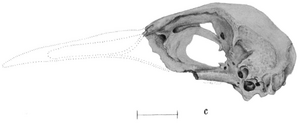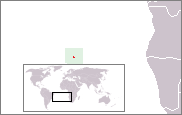Saint Helena rail facts for kids
Quick facts for kids Saint Helena rail |
|
|---|---|
 |
|
| Drawing of the skull, with the missing beak speculatively restored with dashed lines. | |
| Conservation status | |
| Scientific classification | |
| Genus: |
Aphanocrex
|
| Species: |
podarces
|
 |
|
| Location of Saint Helena | |
| Synonyms | |
|
|
The Saint Helena rail (Aphanocrex podarces) was a large bird that could not fly. It lived only on the island of Saint Helena. Sadly, this unique bird disappeared in the early 1500s.
Contents
What Was the Saint Helena Rail?
This bird was a type of rail, which is a family of birds often found in wetlands. The Saint Helena rail was quite big, almost the size of the weka bird from New Zealand. However, it was a bit more slender.
Scientists learned about this bird from old bones found on Saint Helena. An American bird expert named Alexander Wetmore first described it in 1963. He gave it the scientific name Aphanocrex podarces.
Its Scientific Name
For a while, some scientists thought the Saint Helena rail was closely related to another bird called the Inaccessible Island rail. They even suggested putting it in the same group, or genus, called Atlantisia. But later, other scientists decided it was different enough to stay in its own genus, Aphanocrex. So, its full scientific name is Aphanocrex podarces.
How the Saint Helena Rail Lived
The island of Saint Helena had no natural predators for birds until the 1500s. Because of this, the Saint Helena rail did not need to fly to escape danger. Over time, it lost its ability to fly completely.
Even though it couldn't fly, its wings were still quite strong. It also had powerful toes with long claws. These strong feet helped it climb the steep hills and valley walls on the island.
What It Ate
The Saint Helena rail likely ate a variety of foods. It probably hunted for the eggs and young birds of other species living on the island. It also fed on snails.
Why It Disappeared
Like many other ground-nesting birds on Saint Helena, the rail faced a new threat after the year 1502. This was when people started bringing new animals to the island.
Animals like cats and rats, which were not native to Saint Helena, became a big problem. These new predators hunted the Saint Helena rail and its eggs. Because the rail could not fly away to safety, it became an easy target. This led to its extinction in the early 16th century.
See also
 In Spanish: Aphanocrex podarces para niños
In Spanish: Aphanocrex podarces para niños


